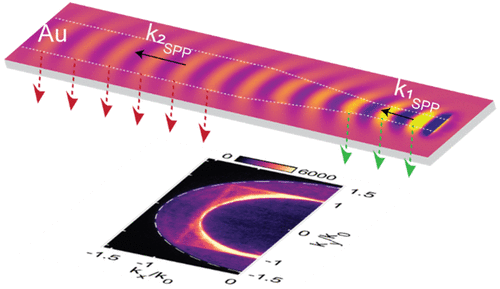当前位置:
X-MOL 学术
›
ACS Photonics
›
论文详情
Our official English website, www.x-mol.net, welcomes your
feedback! (Note: you will need to create a separate account there.)
Geometric Control Over the Edge Diffraction of Electrically Excited Surface Plasmon Polaritons by Tunnel Junctions
ACS Photonics ( IF 6.5 ) Pub Date : 2021-11-12 , DOI: 10.1021/acsphotonics.1c01173 Andreea Radulescu 1, 2, 3 , Vijith Kalathingal 2, 3, 4 , Christian A. Nijhuis 1, 2, 3, 5
ACS Photonics ( IF 6.5 ) Pub Date : 2021-11-12 , DOI: 10.1021/acsphotonics.1c01173 Andreea Radulescu 1, 2, 3 , Vijith Kalathingal 2, 3, 4 , Christian A. Nijhuis 1, 2, 3, 5
Affiliation

|
Plasmonic metal–insulator–metal tunnel junctions (MIM-TJs) readily excite surface plasmon polaritons (SPPs) by inelastic electron tunneling, well below the diffraction limit, eliminating the need for bulky optical elements. The highly confined MIM cavity mode (MIM-SPP) excited by the tunneling electrons dominantly outcouples to photons and single-interface SPPs which further outcouple as photons and give characteristic features in the Fourier plane of observation. Here, we employ SPP waveguides, directly integrated with MIM-TJs, to explore the diffraction of single-interface SPPs at the edges of the metal stripe waveguides. In addition to the leakage of the SPP modes through the metal electrodes, SPP edge diffraction presents as an additional channel for SPP outcoupling, not limited by the thickness of the waveguide. Edge diffraction manifests as a straight-line feature in the Fourier plane of the far-field and by systematically varying the width of the waveguides, we show that the in-plane momentum of the SPPs can be controlled, which in turn leads to control over the edge diffraction. We fabricated MIM-TJs with integrated plasmonic stripe waveguides of different widths, and the propagation and confinement of the SPP modes along the edges of the SPP waveguides are directly identified by the experimental back focal plane imaging, which are further corroborated by numerical simulations. Our findings can be exploited for applications ranging from sensing to nonlinear plasmonics, where focusing and localization of SPP fields are necessary.
中文翻译:

隧道结对电激发表面等离子体激元边缘衍射的几何控制
等离子体金属 - 绝缘体 - 金属隧道结(MIM-TJ)通过非弹性电子隧道很容易激发表面等离子体激元(SPP),远低于衍射极限,消除了对庞大光学元件的需要。由隧道电子激发的高度受限的 MIM 腔模式 (MIM-SPP) 主要与光子和单界面 SPP 耦合,后者进一步作为光子耦合并在傅立叶观察平面中提供特征特征。在这里,我们采用直接与 MIM-TJ 集成的 SPP 波导来探索金属条纹波导边缘处单界面 SPP 的衍射。除了 SPP 模式通过金属电极泄漏之外,SPP 边缘衍射作为 SPP 外耦合的附加通道,不受波导厚度的限制。边缘衍射表现为远场傅里叶平面中的直线特征,通过系统地改变波导的宽度,我们表明可以控制 SPP 的面内动量,从而控制边缘衍射。我们制造了具有不同宽度的集成等离子体条纹波导的 MIM-TJ,并且 SPP 模式沿 SPP 波导边缘的传播和限制通过实验后焦平面成像直接识别,这进一步通过数值模拟得到证实。我们的发现可用于从传感到非线性等离子体的应用,其中 SPP 场的聚焦和定位是必要的。我们表明可以控制 SPP 的面内动量,从而控制边缘衍射。我们制造了具有不同宽度的集成等离子体条纹波导的 MIM-TJ,并且 SPP 模式沿 SPP 波导边缘的传播和限制通过实验后焦平面成像直接识别,这进一步通过数值模拟得到证实。我们的发现可用于从传感到非线性等离子体的应用,其中 SPP 场的聚焦和定位是必要的。我们表明可以控制 SPP 的面内动量,从而控制边缘衍射。我们制造了具有不同宽度的集成等离子体条纹波导的 MIM-TJ,并且 SPP 模式沿 SPP 波导边缘的传播和限制通过实验后焦平面成像直接识别,这进一步通过数值模拟得到证实。我们的发现可用于从传感到非线性等离子体的应用,其中 SPP 场的聚焦和定位是必要的。并且 SPP 模式沿 SPP 波导边缘的传播和限制由实验后焦平面成像直接识别,并通过数值模拟进一步证实。我们的发现可用于从传感到非线性等离子体的应用,其中 SPP 场的聚焦和定位是必要的。并且 SPP 模式沿 SPP 波导边缘的传播和限制由实验后焦平面成像直接识别,并通过数值模拟进一步证实。我们的发现可用于从传感到非线性等离子体的应用,其中 SPP 场的聚焦和定位是必要的。
更新日期:2021-12-15
中文翻译:

隧道结对电激发表面等离子体激元边缘衍射的几何控制
等离子体金属 - 绝缘体 - 金属隧道结(MIM-TJ)通过非弹性电子隧道很容易激发表面等离子体激元(SPP),远低于衍射极限,消除了对庞大光学元件的需要。由隧道电子激发的高度受限的 MIM 腔模式 (MIM-SPP) 主要与光子和单界面 SPP 耦合,后者进一步作为光子耦合并在傅立叶观察平面中提供特征特征。在这里,我们采用直接与 MIM-TJ 集成的 SPP 波导来探索金属条纹波导边缘处单界面 SPP 的衍射。除了 SPP 模式通过金属电极泄漏之外,SPP 边缘衍射作为 SPP 外耦合的附加通道,不受波导厚度的限制。边缘衍射表现为远场傅里叶平面中的直线特征,通过系统地改变波导的宽度,我们表明可以控制 SPP 的面内动量,从而控制边缘衍射。我们制造了具有不同宽度的集成等离子体条纹波导的 MIM-TJ,并且 SPP 模式沿 SPP 波导边缘的传播和限制通过实验后焦平面成像直接识别,这进一步通过数值模拟得到证实。我们的发现可用于从传感到非线性等离子体的应用,其中 SPP 场的聚焦和定位是必要的。我们表明可以控制 SPP 的面内动量,从而控制边缘衍射。我们制造了具有不同宽度的集成等离子体条纹波导的 MIM-TJ,并且 SPP 模式沿 SPP 波导边缘的传播和限制通过实验后焦平面成像直接识别,这进一步通过数值模拟得到证实。我们的发现可用于从传感到非线性等离子体的应用,其中 SPP 场的聚焦和定位是必要的。我们表明可以控制 SPP 的面内动量,从而控制边缘衍射。我们制造了具有不同宽度的集成等离子体条纹波导的 MIM-TJ,并且 SPP 模式沿 SPP 波导边缘的传播和限制通过实验后焦平面成像直接识别,这进一步通过数值模拟得到证实。我们的发现可用于从传感到非线性等离子体的应用,其中 SPP 场的聚焦和定位是必要的。并且 SPP 模式沿 SPP 波导边缘的传播和限制由实验后焦平面成像直接识别,并通过数值模拟进一步证实。我们的发现可用于从传感到非线性等离子体的应用,其中 SPP 场的聚焦和定位是必要的。并且 SPP 模式沿 SPP 波导边缘的传播和限制由实验后焦平面成像直接识别,并通过数值模拟进一步证实。我们的发现可用于从传感到非线性等离子体的应用,其中 SPP 场的聚焦和定位是必要的。











































 京公网安备 11010802027423号
京公网安备 11010802027423号